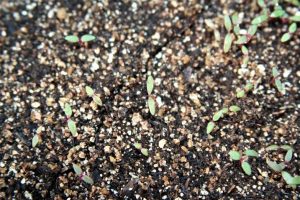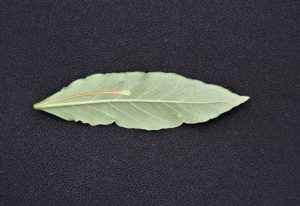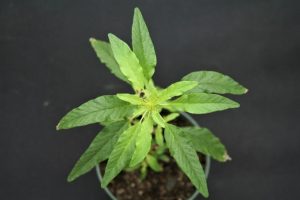Waterhemp is prevalent in the Midwest and the Great Plain States. It became a significant agricultural weed in 1990s. Before then it was present in crop fields, but it is presumed that it rarely reached economic infestations. It became a problem in Indiana by 1998. Waterhemp is best adapted where less aggressive tillage is practiced. The adoption of conservation tillage might have aided in its widespread establishment. Also, the use of herbicides in the late 1980s coincided with the spread of waterhemp, and it quickly became resistant to Group 2 herbicides (ALS-inhibitors). Today waterhemp populations have been documented to also have resistance to Groups 5 (Photosystem II-inhibitors), 9 (glyphosate), 14 (PPO-inhibitors) and 27 (HPPD-inhibitors or “bleachers”).
Identification: At the seedling stage, it can be difficult to distinguish waterhemp from other pigweeds. Cotyledons are egg- to ovate-shaped (Figure 1). When plants are larger, waterhemp can be differentiated because it has no hair on the stem or leaves like most pigweeds. It can be distinguished from Palmer amaranth because its petioles are shorter than its leaf blades (Figure 2) unlike Palmer amaranth which has petioles at least as long as its leaf blades. Waterhemp leaves are elongated and have a shiny/waxy appearance (Figure 3).
Growth habit: Waterhemp is a summer annual weed that emerges late in the season with a growth rate of approximately 1 inch per day. Its high growth rate makes it very competitive with the crop and other weeds. Late emergence allows waterhemp to avoid pre-emergence herbicides. The first waterhemp plants to emerge are the most competitive and have the greatest potential to produce large numbers of seeds. Later emerging plants are often less competitive, but are still capable of producing seeds that will have to be controlled the next season.
Reproduction: Waterhemp reproduces by seed and has male and female flowers on separate plants (dioecious). A female plant can produce 250,000 seeds, but some plants have been found to produce 1 million or more seeds in optimal conditions. Because waterhemp is dioecious, plants have more potential to evolve and spread herbicide resistance genes.
Integrated weed management strategies
Cultural and mechanical/physical practices:
- Mulch: Plastic mulch provides a physical barrier that prevents waterhemp from growing. Avoid excessively large planting holes and tears that will provide a space for weeds to establish. Row middles will still need to be managed with one or more of the methods below. (Note: Rolled cover crop residue can also provide a physical barrier and aid in waterhemp suppression. The degree of control is often related to the amount of biomass produced by the cover crop, where more is better.)
- Deep tillage: Because waterhemp seeds are small, they only emerge from the uppermost portion of the soil. Tillage that inverts the soil and buries the seeds deeply can reduce waterhemp pressure and facilitate decay of waterhemp seeds.
Chemical control:
Waterhemp resistance to multiple herbicides is well documented. The best chemical control options will depend on the crop grown and the specific population of waterhemp present. For more information on chemical control options, consult the Midwest Vegetable Production Guide at https://mwveguide.org/ and the product labels.
- Don’t rely entirely on post-emergence herbicides. Post-emergence options for broadleaf weed control in vegetable crops are limited and typically rely on Group 5 and 2 herbicides, both of which have documented waterhemp resistance. Where permitted, the use of a broad-spectrum herbicide applied as a directed or hooded spray to row middles will control susceptible plants. Post-emergence applications should be made to small (less than 4” tall) waterhemp.
- Do use pre-emergence herbicides. Season-long control may require more than one application of residual herbicides. If the production system allows, the use of pre-emergence herbicides at planting then again at layby will provide longer-term control. Use multiple modes of action when possible and apply to a weed-free surface as most pre-emergence herbicides will provide little or no control of emerged weeds. Commonly used herbicides that offer control include those from Group 15 (Dual Magnum®, Zidua®), Group 4 (Valor®/Chateau®, Reflex®), and Group 3 (Prowl®, Treflan®).
- Evaluate if the herbicide application was effective. After any control measure it is important to scout fields to determine treatment effectiveness. This allows for follow-up action if needed. It will also help you identify which herbicides your waterhemp population is susceptible and resistant to.
- Consider rouging, if possible. When possible, do not allow waterhemp escapes to establish; rogue them before they get to a reproductive stage. Although this is often done by hand and hoe when labor is available, mowing or electrocuting (“zapping”) may also be suitable options to manage escapes.
- Consider combining chemical control practices with cultural and mechanical control practices. Better control is achieved when using cultural practices and focusing on pre-emergence plus post-emergence herbicides applications.
References:
Hartzler, B. (2019). Waterhemp: A “friendly” native evolves into the Cornbelt’s worst weed problem. Iowa State University Extension and Outreach. https://crops.extension.iastate.edu/blog/bob-hartzler/waterhemp-friendly-native-evolves-cornbelts-worst-weed-problem
Loux, M. M., Doohan, D., Dobbels, A. F., Johnson, W. G., Young, B. G., Legleiter, T. R., & Hager, A. (2017). Weed control guide for Ohio, Indiana and Illinois.
Petrovic, K. (2020). Field Scouting Guide: Waterhemp. Growing Produce. https://www.growingproduce.com/vegetables/field-scouting-guide-waterhemp/


